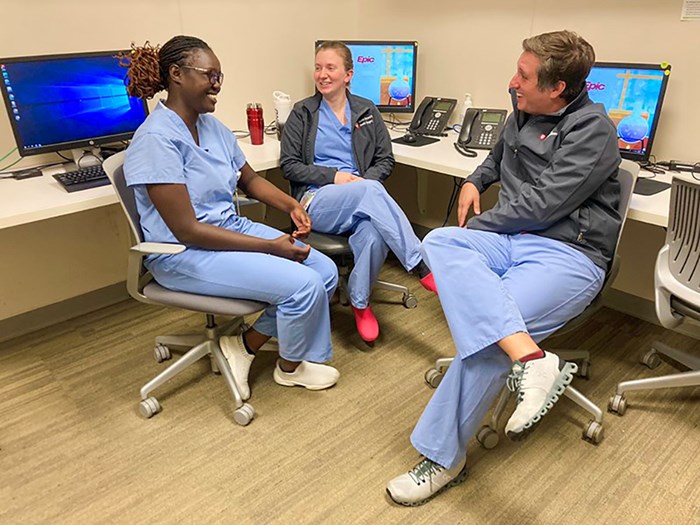From Africa to America: Takeaways from a month in Indiana

I embarked upon my first journey to the United States in July 2022, courtesy of a one-month global health exchange program between the plastic surgery division of Indiana University and Moi Teaching and Referral Hospital (MTRH) in Eldoret, Kenya, as part of the Academic Model Providing Access to Healthcare (AMPATH) program.
I had the good fortune to rotate in four departments during my month in Indiana. I started with trauma service at Sidney and Lois Eskenazi Hospital in Indianapolis under Clark Simons, MD. At Eskenazi, I shadowed residents in the trauma service as they conducted ward rounds and responded to emergency cases. It was interesting to me that the leader of the trauma response team was the chief resident, who mobilized the team and assigned roles to each person attending to the patient. The organization and coordination of the team was inspiring, and I was excited to encourage this kind of practice in Kenya. In addition to shadowing the trauma team, I was also able to assist in some minimally invasive surgical procedures – both laparoscopic and robotic surgeries. Although we have laparoscopic surgery in Kenya, it's not as widely practiced as in the United States – primarily because the equipment is expensive and most surgeons lack the expertise. My rotation at Eskenazi was my first experience with robotic surgery, and I was taken with its precision.
My second week was in the burns center at Eskenazi Hospital under Leigh Spera, MD, who led a truly diverse team that included residents from Pakistan, Iran, India and Canada. I found it incredibly interesting to compare medical practice in the different places and gain the residents' perspective of working and studying in the United States. The facilities available in the burns unit at Eskenazi are world-class and, for the first time in my career, I had the chance to witness a patient who had more than a 60 percent burn-surface area survive the wounds thanks to the availability of a 24-hour critical care unit. It was also the first time I saw cadaveric allografts used in burn management. I was awed by the advanced instruments available for procedures, such as the waterjet hydro surgery system for wound debridement, the use of a Zimmer Dermatome and derma carriers that make surgery both fast and efficient.
My third week in Indiana was at the hepatobiliary/endocrine service at the Indiana University (IU) Hospital where I had the chance to participate in Whipple procedures, parathyroidectomy and thyroidectomy, in addition to attending hepatobiliary clinics. The clinics are run in stark difference to the surgical clinics in MTRH. The patients are assigned rooms and the doctor can peruse their charts prior to going to the rooms to discuss the patients' progress after surgery, any impending procedure or the next step of care in their treatment. In Kenya, patients often queue outside the doctor's room as they await their turn to be seen.
My final week was spent rotating in breast surgery at Methodist Hospital, where I was able to assist in breast augmentation procedures, oncoplastic surgery and other procedures. In addition to the rotations, I attended resident education sessions – both at Eskenazi and at the IU hospital – as well as morbidity and mortality meetings. It was interesting to observe residents' interactions with the attendings and how relaxed the sessions were. I was impressed by the way the attendings and professors took accountability for their procedures and how they were open to criticism.
It wasn't all work and no play, though. I had the opportunity to visit the Indiana State Fair, and we also had the chance to see an Indianapolis Colts game – my first time experiencing American football, which was exhilarating. The global health-exchange program doctors who had been to Kenya also organized get-togethers with their families, which allowed us to talk about about their time in Kenya and the differences in practicing medicine at home and abroad.
All in all, I'm grateful for the opportunity to travel and experience different cultures. The program afforded me the opportunity to work with brilliant surgeons and residents who were more than willing to teach, discuss and learn. Global health provides us an opportunity to optimize patient care, not only through exposure to different medical care facilities, but also through the bilateral case conferences that shine a light on best practices. It's my sincere hope that more residents have similar opportunities to participate in global health opportunities.
Dr. Munda, who's training at Moi Teaching and Referral Hospital (MTRH) in Eldoret, Kenya, is the first Kenyan surgery resident to complete a surgery rotation at Indiana University through the AMPATH partnership.